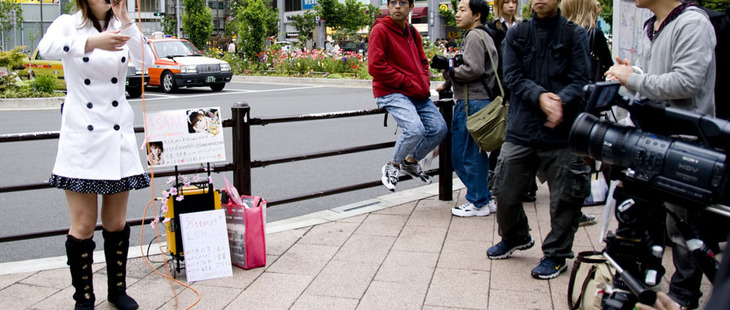
The hobo flower-seller wearing the Beyonc band-aid on his scalp was still dancing, throwing roses to the assembled onlookers, when the police car pulled up. Nervous faces in the crowd looked back at a young woman in pigtails.
They needn’t have worried. Misa, who only 20 seconds before had herself been singing and dancing on the pavement, had already smoothly slipped the microphone into the folds of her jacket and snapped shut the amplifier, transforming it into an everyday briefcase. She began casually chatting with one of the young men near her.
The rest of her audience – a hundred or so men and women, mostly under 25 – tried to mill about innocuously, as though they all just happened to be clumped together on this particular stretch of sidewalk by chance.
Two cops emerged from the car. Slowly they walked through the crowd, eyeing people up. Beside me, a young man with yellow teeth, Hiroyuki Nakajima, whispered in my ear: “The cops hate otaku. Only the Yakuza appreciate us – they support us. The cops just want to crack down on us. They hate Japan.”
“What are the police looking for?” I asked.
“Unauthorised performance,” Nakajima said.
Apparently satisfied, the two officers returned to the patrol car and drove down the street. Instead of turning at the corner, however, they parked behind some bushes and peered back at us through binoculars.
“They think we can’t see them through that hedge,” Nakajima said.
*
The earthquake and tsunami in March have sent the Japanese economy into freefall. Japan’s factory output and consumer spending have plummeted. Industrial production is down 15 percent. There were 57 percent fewer cars made last month than a year ago.
But the economy was already drifting before the disaster. Exports were sickly, Toyota disgraced, China ascendant. As attention now turns to fukki, recovery, Japan’s economic prospects look gloomier than ever.
There is, however, one bright spot: the gigantic global empire that is Japanese pop culture. The animated films of Hayao Miyazaki, the Gundam cartoon brand, the Hello Kitty cross-platform merchandising steamroller — these continue to bring trillions of yen to Japan. Japan’s politicians call it “soft power”.
Akihabara is where it comes from. But here on the streets of this simultaneously flashy and seedy district of Tokyo, a contest of wills has been raging – and Misa and her secret fans are on the front lines. Behind all the gigantic computer stores, the tourists gazing into the famous maid cafs, the mini-skirted women standing on boxes shouting through megaphones, the authorities are engaged in a war with the otaku.
*
Akihabara — or Akiba, as it’s known — has long been the spiritual home of Japan’s multimillion-strong community of otaku, hardcore fan-geeks. Akiba is where you go if you want your ears cleaned by a maid, or to dress as a cartoon character without the muttered disapproval of passersby, or to buy new parasol for your photorealistic doll.
It is also the unofficial headquarters of the Japanese pop culture juggernaut. And, in peculiarly Japanese fashion, it is the otaku, the fans themselves, who stoke the furnace of this giant machine. Not only do they help consume the output (toys, video games, anime) of big companies like Namco Bandai, but it is often from their ranks that new ideas and creative talent are found — the huge “dojinshi” culture of unlicensed fan fiction, for example, is a fecund source of new manga artists. One economist estimates otaku pump $26 billion each year into the domestic economy.
There’s just one problem, as far as the authorities are concerned: the otaku themselves. As successive governments have poured money into Akiba in the hopes of developing this culture industry, the “hard” fans — what we might call the real nerds of Akihabara — are no longer welcome.
The backlash against the otaku began in 2008. The area was thriving. Fans flocked to see up-and-coming “idoru” like Misa, one of the many popstar-models who swarm across Japanese media. Every Sunday, Misa performed her particular brand of sparkling-toothed J-pop next to dozens of other amateur singers, all of them standing on the sizzling concrete in the Tokyo sun, emoting profusely, fists clenched to the sky, hoping for their big break.
But as spring unfolded, the district, already simmering with notoriety, began to boil. In April, one desperate young aspirant to idol-hood shimmied up a lamppost. Fifteen feet off the ground, she hitched her dress above her waist and flashed her underwear at her fans. She then descended and led them around the district like a kind of Pied Piperette. The police soon had her in handcuffs. Two months later, a man named Kato Tomohiro drove a rented van straight into a crowd of people, jumped out and began stabbing with a hunting knife. Seven died.
An association of older Akiba residents decided they’d had enough with what they perceived to be the weirdos turning their neighbourhood into a den of iniquity. Wearing janitorial jumpsuits and holding placards reading: “Street performances are illegal,” they marched down Pedestrian Paradise – Akiba’s main boulevard, which was closed to traffic every weekend for 35 years and had become a magnet for idol performances like Misa’s. Police followed behind with truncheons. Shouting, they dispersed fan gatherings and knocked people off their bicycles.
A week after Tomohiro’s killing spree, the Pedestrian Paradise was officially closed. Police began patrolling Akiba in packs. They stopped and searched anyone who looked too nerdy; they broke up idol singer shows and photo shoots, “otagei” performance circles and cross-playing otaku dance routines. And they arrested singers such the Pied Piperette.
Patrick Galbraith knows her. “Yeah, they got Asuka for disturbing the peace and indecent exposure.” He shakes his spiky yellow wig. Galbraith is a PhD candidate in information studies at the University of Tokyo, specializing in otaku studies. He’s also an otaku cosplayer (an abbreviation of costume play) himself. Galbraith is a familiar Akiba sight, dressed in his orange bodysuit and prickly cartoon hairpiece as Goku, the protagonist of Dragon Ball. (A name patch on Galbraith’s suit reads “Gaigokujin”, a play on Goku and the word for foreigner.)
Galbraith is dismayed by what’s happening in Akiba. As the government aims to increase the percentage of manga in Japanese exports from 2 to 18 percent (most of it sown in the 2.6 sq km of Akiba), Galbraith worries that, in an effort to harness Japanese pop cultural power, the authorities appear to be trampling on precisely the otaku who help generate it. In January, the Pedestrian Paradise was reopened, but with strict behavioural rules, including a reinforcement of the ban against performances. That means no idols, and no costumes. “There’s a conflict of interest,” Galbraith says, “a schizo policy of wanting to promote the anime culture without actually having to deal with the real anime culture.”
This sort of crackdown isn’t unique to Tokyo. City authorities around the world are too often prone to shutting down or undermining those very things that give urban centres their vitality, their spontaneity, their identifiable local culture.
Near my flat in London, a commercial housing unit recently held a graffiti competition, to give a few designated wall sections a bit of flair. Locals came out to paint or just to watch. The next week, municipal council contractors were busy underneath a bridge at the nearby Regent’s canal, water-blasting off the murals.
*
Costume-play is integral to Akiba. Galbraith calls his own cosplaying “a full-on immersion in participant observation.” But as giggling tourists ask him to pose — he obliges by squatting, palms face out, and adopting a frozen, quivering, scream/yell expression, Goku channeling his giant fireball — it’s clear it’s also a lot of fun.
“Cosplay is role play, it’s like Halloween,” says I.A. Kurosaki over coffee and cake at a cosplay cafe. The waitresses and many customers are dressed as cartoon characters. They engage in formalized banter, often based on scenes from specific anime. Today Kurosaki has come as Shinji, a character from Vampire Knight. A somewhat stiff woman with the habit of abruptly throwing her voice several octaves either up or down to make a joke, Kurosaki says she only feels comfortable in her own skin, as it were, when she dons the unsettling blue contact lenses and white-and-black outfit of Shinji.
“It’s like being a kid again,” she says.
Kurosaki and Galbraith agree that for otaku, Akiba is more than an electronics district. It’s a place where the proverbial Japanese nail that sticks up will not, in fact, get hammered down. Being otaku is a way for Japanese who don’t subscribe to their country’s heavily brand-dominated cultural mainstream to establish some sense of belonging to a secret society within their blandly conformist world. One Nomura Research Institute consultant suggests 2.85 million Japanese self-identify in some way as otaku.
*
This otaku-ness takes all forms. Some people lavish their attentions on hyper-realistic dolls. They dress them, accessorize them, marry them and (for “wet” or particularly active users) carry them around in violin cases. Others spend days queuing for tickets to AKB-48, an all-girl dance act that plays daily on the top floor of the Don Quixote department store and makes a virtue of amateurishness. The mistakes make the singers seem more human, and thus easier for fans to love.
Nearby Kanda Myojin street is lined with souped-up cars that are covered in decals of anime characters, such as Nanoha Takamachi, from the TV series Magical Girl Lyrical Nanoha. The cars are known as itasha, “ouch cars”. The pain is that of, yes, being misunderstood.
One owner, Jun, jokingly acts this out by covering his eyes and pretending to cry out in anguish, eliciting a laugh from the other itasha drivers nearby. They come to Kanda Myojin street because they know there will always be a few other itasha around. “We want to show off,” says Jun. These men aren’t social misfits. They have families and corporate jobs. One of them memorably reassured a Japan Times reporter that “none of us parks illegally.”
For otaku, it doesn’t matter what you love as long as you love it wholeheartedly and purely. There’s a word that helps describe this intensity of delicate feeling: moe (mo-ay). “Moe is a way to capture emotion you can’t verbalize,” Galbraith says. “It’s like a second form of love.”
Rather like love, too — if you need to ask what it is, you aren’t feeling it. Anime News Network calls moe a term to “describe something precious, usually the ideal of youthful and innocent femininity.” The best literal translation is something like “burning passion” (the kanji ideogram means blossom, while the sound means burning). The term has now gone mainstream. “It’s post-otaku,” Galbraith says. “Even beautiful girls say it now. Non-otaku say it. It’s on train signboards. It’s on weight loss ads.”
In practice, moe is sometimes expressed in an active transference of emotional energy between performers — such as idols like Misa, or waitresses dressed as maids, or the slice of the great Japanese Venn diagram where both groups intersect — and their fans.
Moe can be witnessed firsthand at the Dear Stage maid caf, where every so often a maid-waitress grabs a microphone and giddily belts out a J-pop number, accompanied by a lot of YMCA-style posing.
On my visit to the similar Misty Heaven caf (since closed), a customer watching the performance (while wearing headphones) started making a strange, expansive gesture, as if pushing beach balls forward with his palms.
“Moe,” murmured Galbraith. “He’s sending her love, reflecting it back, showing her that her talents are appreciated.” This is a version of otagei, stylised dance moves with names such as Romance and Matrix, all designed to express moe to the performer. (Even moe isn’t what it used to be. Tetsu, a friend of mine, told me he’s tired of some otagei practitioners who flail around madly. “These days it’s all about ego,” Tetsu said, “and not about real moe.”)
Everywhere, there is laughter, conversation, flirting — not only in the maid cafs, but in the arcades, electronics shops and cosplay cafes. Nearly half the participants are women; there are lots of students just hanging out. Whether you are into otagei, cosplay or itasha, it’s easy enough to see what being otaku in Akiba is all about: making friends and belonging.
The crackdown is changing all that. “Lots of otaku are not coming to Akiba any more,” Galbraith says. “It’s not as easy to simply come and enjoy — the otaku are relegated back to their rooms.”
*
For most of the 1980s and 90s, the otaku were just that: a bedroom community. Otaku were left alone to their pursuits: custom-building PCs, clipping magazine photos of idol popstars into giant binders, trading manga and figurines, and generally embodying a living tribute to their country’s unique pop culture. Mainstream society, sickened by the “otaku killer” murders of 1988-89 (in which a man widely identified as otaku killed four girls), wrote them off as perverts and misfits, when it wasn’t ignoring them entirely.
But in the new century, the otaku grew increasingly confident, and the growing buzz became a roar in 2005 with the film Densha Otoko. “Train Man” tells the true-ish story (played out in Akiba and the vast Ni-Chaneru online forum) of a “normal” girl who falls in love with a stereotypical otaku. It not only capitalized on otaku culture, it helped legitimize it. That year, Taro Aso — then culture minister, and an avid manga reader — gave a famous speech at Akihabara campus in which he declared (in so many words), “Ich bin ein otaku.” They still sell Taro Aso-shaped cookies on the streets here in his honour.
When Aso became prime minister, he helped channel billions of yen into Akiba: gleaming new developments like the UDX building, home to Japan Anime Collaboration Market, a cultural hothouse to grow new anime or character brands in the hope of hitting the merchandising jackpot. This incubation of Japan’s soft power, however, sent rents skyrocketing. Starbucks and McDonalds outbid local shopkeepers. Otaku-focused businesses have struggled or closed.
The open hostility of the police hasn’t helped. Just blocks from the shiny UDX building lies the “Dark Heart”: a rabbit-warren of narrow streets clustered with otaku shops. The Dark Heart is very much a fringe area. It gives birth to much of the country’s pirated software. It was also where the Aum Shiniryko cult had their headquarters before their 1999 sarin gas attack in Tokyo’s subway.
For decades, the police left the Dark Heart alone. Since last summer, though, they have been cruising in patrol cars up the cramped streets, in an ostentatious show of force. Anyone caught after dark merely dressed a little strangely was, for a time, sure to get searched.
Ten years ago, it was teenage wannabe gangsters who’d hunt Akiba nerds for their lunch money; now it’s the cops the otaku fear. Even if they weren’t being driven out by the high rents, the message is clear: the authorities want to sanitize Akiba, to rid it of nerds and nudity, of piracy and performance. The otaku are now outcasts in their own district as well.
Christopher Michael is a culture writer for the Guardian and runs the ad-review website Hawkblocker.com

















